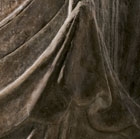J.J. Lally & Co., Oriental Art / New York City, New York
MenuPast Exhibition
Two Thousand Years of Chinese Sculpture
March 17-29, 2008
11.
A MARBLE TORSO OF BUDDHA
Late Northern Qi/ Sui Dynasty, circa 575 - 600
seated in virasana with legs folded under his layered monastic robes, the broad-shouldered figure leaning back very slightly in a controlled but relaxed posture of meditation, with a carefully knotted cord over one shoulder drawing the robes into a fan-shaped cluster of pleats at one side in front and attached to a simple clasp in back, the bared chest left plain and smooth, the fragmentary left hand resting on the knee and the right hand now missing, originally raised in abhaya mudra, the gesture of absence of fear, the back more simply carved to show the robes in neat flattened folds, the fine white marble with attractively mottled uneven russet-colored patination all over.
Height 25 inches (63.5 cm)
A closely related white marble seated torso of Buddha with missing hands in the same positions, in the museum at Dingzhou, Hebei province, is illustrated by Siren, Chinese Marble Sculptures of the Transition Period, Bulletin of the Museum of Far Eastern Antiquities, No. 12, Stockholm, 1940, Pl. V d, described on p. 485 as a representation of “Sakyamuni Buddha conceived as a more youthful human being.” Another similarly carved white marble headless seated Buddha in The Museum of Far Eastern Antiquities, Stockholm is illustrated by Siren, ibid, Pl. V c, and the author describes these sculptures as “… executed with a degree of technical skill and refinement that we hardly can expect before the very end of the Northern Ch’i dynasty (577).”
Compare also the white marble seated torso of Buddha in The Palace Museum, Beijing, illustrated by Matsubara in Chūgoku Bukkyō chokokushi ron (Historical Discussion of Chinese Buddhist Sculpture), Tokyo, 1995, vol. II, no. 505b, attributed to the Tang dynasty.
北齊晚期 / 隋 漢白玉佛坐像 高 63.5 厘米
